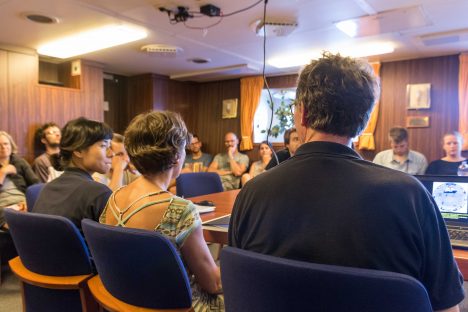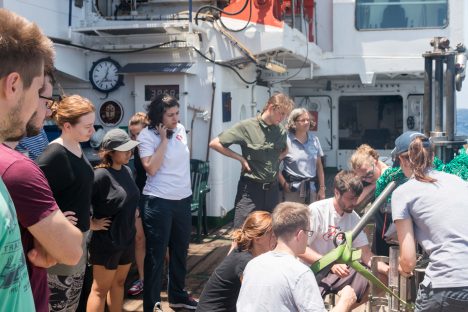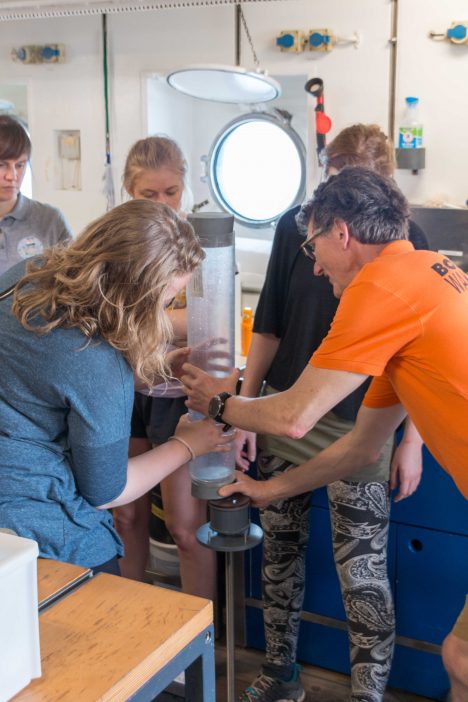Dear interested reader, colleagues, friends and families,
there are regular presentations given by our scientists on the RV Meteor (Image 1). The first presentation was given by the PhD student Alexandra Schönle from Cologne on her research topic “Protists in the Deep Sea”: How do protists (single-celled eukaryotes, which store DNA in a nucleus) survive the high pressure in the deep sea and which methods are suitable to measure effects of pressure? The next talk will be presented by Drs. Eva Sintes and Chie Amano from Vienna on the activity of prokaryotes (single cells without nucleus or other compartments) in the deep sea.
We are getting closer to the first sampling station, where we will arrive on Wednesday. The sampling of deep-sea sediments will take about one day, requires a detailed protocol and the full attention of our scientists. Therefore, all participants were trained today to handle the valuable multicorer (MUC) cores carefully and quickly (Image 2,3). Each of the MUC cores will be important for different research topics: Which biodiversity can be found in the water and in the sediment, respectively? What are the relative numbers of individuals for certain groups of organisms? Which groups of organisms are really active? It will be interesting, whether the water fraction and the first millimetres of sediment differ concerning our questions. Once we obtain a single MUC core, all organisms will be immediately counted and identified. With this approach, we aim to visualize the complex network of organisms in the deep sea. Our main focus lies on the microbial organisms which are potentially most important for the carbon flux.
Your M139 team
–
Liebe interessierte Leser, Kollegen, Freunde und liebe Familien,
in regelmäßigen Abständen halten unsere Wissenschaftler Vorträge über ihre eigene Arbeit auf der FS Meteor (Bild 1). In einem ersten Vortrag informierte uns die Kölner Doktorandin Alexandra Schönle über ihr Thema „Protisten in der Tiefsee“: Wie können Protisten (eukaryotische Einzeller, die ihre DNA in einem Zellkern von den anderen Zellbestandteilen durch eine Membran separariert haben) den enormen Druck in der Tiefsee überleben und welche geeigneten Methoden gibt es, um die Effekte von Druck auf Protisten zu messen? Die nächsten Vorträge werden von Dr. Eva Sintes und Dr. Chie Amano aus Wien über die Aktivität von Prokaryoten (Einzeller, die ihre DNA nicht in einem Zellkern konzentriert haben) in der Tiefsee gehalten.
Wir nähern uns der ersten Station für Beprobungen, die wir am Mittwoch erreichen werden. Die Beprobung von Tiefsee-Sedimenten wird einen ganzen Tag in Anspruch nehmen und das detaillierte Protokoll wird die volle Aufmerksamkeit unserer Wissenschaftler erfordern. Daher übten heute alle Beteiligten, mit den wertvollen Bohrkernen des Multicorer (MUC) sorgfältig und schnell umzugehen (Bild 2,3). Jeder MUC-Bohrkern wird für unterschiedliche Forschungsthemen wichtig sein: Welche Biodiversität wird jeweils im überstehenden Wasser und im Sediment zu finden sein? Was sind die relativen Individuenzahlen für die einzelnen Organismengruppen? Welche Organismengruppen sind wirklich aktiv? Es wird interessant sein, ob sich die Proben der Wassersäule von denen der ersten Millimeter Sediment hinsichtlich dieser Fragen unterscheiden. Sobald ein einzelner MUC-Bohrkern geborgen wird, werden umgehend alle Organismen gezählt und identifiziert. Wir versuchen mit diesem Ansatz das komplexes Netzwerk an Organismen in der Tiefsee aufzudecken, wobei unser Hauptaugenmerk auf den kleinsten Organismen liegt, die für den Hauptteil des Stoffumsatzes verantwortlich gemacht werden.
Ihr M139-Team

Image 1 | Science meeting in the conference room. (Photo: Johannes Werner)

Image 2 | Training of the scientists to handle the multicorer (MUC). The first valuable MUC cores from the deep sea will be obtained on Wednesday. (Photo: Johannes Werner)

Image 3 | Each MUC core has to be processed carefully and quickly. Both the water column and the first millimetres of the sediment will be important for our research. (Photo: Johannes Werner)
Liebes Team auf der Meteor
Toller Blog!
Viel Erfolg bei der Probennahme morgen und eine ruhig See.
Liebe Grüße
Norbert und Christiane Ahlers